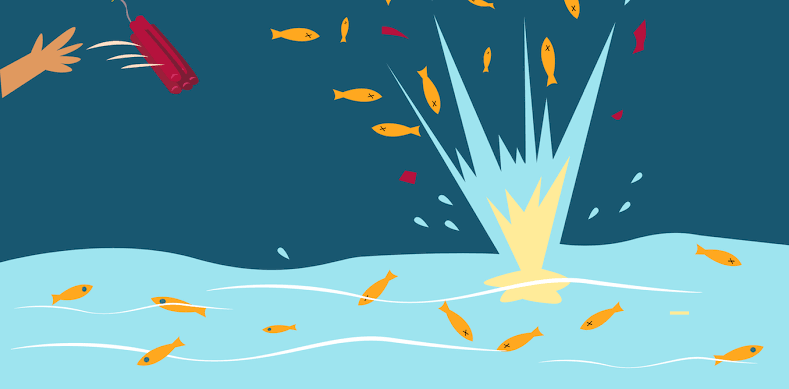Blast Fishing

Blast Fishing is one of the very destructive, illegal way of killing the school of fish together. In this, explosives such as dynamites are used to kill the fish . It is one of the most inhumane techniques used in today’s time. It is also known as Fish Bombing, Dynamite Fishing etc.. This technique is adopted by the farmers/fisherman who want to save money while collecting the fish and save time as well. But it makes very difficult for the poor fishermen to survive in the market as this reduces the availability of fish for them affecting their incomes. It can also result in increased poverty and food insecurity in coastal areas that rely heavily on fishing. It is practised in more than 40 countries throughout the globe especially near the coastal areas , coral reefs etc . To carry out this technique fishermen typically throw the explosive device into the water. Once detonated, the shockwaves produced by the explosion can kill the fish making it easier for them to collect. It harms the coral reefs which is essential for the survival of the fish . Coral reefs are less likely to recover from constant disturbance caused by the blast fishing. It takes 5-10 years for a reef to recover from a single blast done by a farmer.Most of the time only four out of ten fish float on the surface and rest sink to the bottom of the seabed . The indirect damages caused by blast fishing are that the explosives contaminate the water leading to water pollution and other than fishes, different sea animals are also killed in this techique thereby reducing the fish population. According to one study , there were 850,000 blast fishing incidents recorded between 2006-2016 in Hong Kong, Malaysia and the Philippines alone. It is an extremely dangerous practice as those explosions done to kill the fish can harm the fisherman and surrounding people leading to serious injuries. Therefore , ways should be taken by the governments to stop this destructive technique by enforcing strict rules and regulations. High penalties should be charged . Other than that the government can organise programmes and campaigns in order to create awareness among the fishermen and the local communities about the negative impacts of blast fishing. They should provide training and resources to the fishermen to move to other possible livelihood options. International cooperation is needed to mitigate this technique from the globe.In 2006 background blast monitoring (BBM) with this same equipment was installed at Mabul Island in Sabah, Malaysia. In 2014 the Reef Defenders began an aggressive program to create a network of blast monitoring systems throughout South-East Asia. BBM is important to guide community-based eradication programs, data collected shows that with the use of community-based programs in tandem with BBM, the levels of blast fishing can be reduced by up to 90%.This has already been observed in multiple areas, more importantly, there is a significant reduction in other destructive fishing methods, shown by recovery in fish stocks. By adopting a comprehensive approach it is possible to significantly reduce and finally stop blast fishing.
Author – Khushi Singh, a student of Dr.BR Ambedkar National Law University, Sonepat



